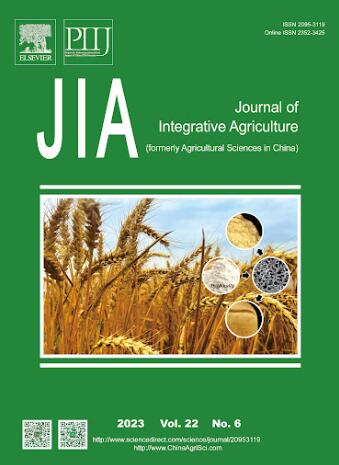Mining elite loci and candidate genes for root morphology-related traits at seedling stage by genome-wide association studies in Upland Cotton (Gossypium hirsutum L.)
IF 4.4
1区 农林科学
Q1 AGRICULTURE, MULTIDISCIPLINARY
引用次数: 0
Abstract
The root system architecture plays an essential role in water and nutrient acquisition in plants and is significantly involved in plant adaptation to various environmental stresses. In this study, a panel of 242 cotton accessions was collected to investigate six root morphological traits at the seedling stage, including main root length (MRL), root fresh weight (RFW), total root length (TRL), root surface area (RSA), root volume (RV), and root average diameter (AvgD). The correlation analysis between six root morphological traits revealed a strong positive correlation of TRL with RSA, RV with RSA and AvgD, whereas a significant negative correlation between TRL and AvgD. Subsequently, a genome-wide association study (GWAS) was performed using the root phenotypic data and genotypic data reported previously for 242 accessions using 56,010 single nucleotide polymorphisms (SNPs) from the CottonSNP80K array. A total of 41 quantitative trait loci (QTLs) were identified with 9 for MRL, 6 for RFW, 9 for TRL, 12 for RSA, 12 for RV and 2 for AvgD respectively. Among them, 8 QTLs were repeatedly detected in two or more traits. Integrated with transcriptome analysis, we identified 17 candidate genes with high transcripts of transcripts per million (TPM)≥30 in roots. Furthermore, we verified functionally a candidate gene encoding a WPP domain protein 2 in root development. Virus-induced gene silencing (VIGS) assay showed that knocking down significantly inhibited root development in cotton, indicating its positive role in root system architecture formation. Together, these results provide a theoretical basis and candidate genes for cotton root developmental biology and root-related cotton breeding.通过对陆地棉(Gossypium hirsutum L.)的全基因组关联研究挖掘苗期根系形态相关性状的精英位点和候选基因
根系结构在植物获取水分和养分的过程中起着至关重要的作用,并在植物适应各种环境胁迫的过程中发挥着重要作用。本研究收集了 242 个棉花品种,研究了幼苗期的六个根系形态特征,包括主根长度(MRL)、根鲜重(RFW)、总根长度(TRL)、根表面积(RSA)、根体积(RV)和根平均直径(AvgD)。六种根形态性状之间的相关分析表明,TRL与RSA、RV与RSA和AvgD呈强正相关,而TRL与AvgD呈显著负相关。随后,利用之前报告的 242 个品种的根表型数据和基因型数据,使用 CottonSNP80K 阵列中的 56,010 个单核苷酸多态性(SNPs)进行了全基因组关联研究(GWAS)。共鉴定出 41 个数量性状位点(QTLs),分别为 9 个 MRL、6 个 RFW、9 个 TRL、12 个 RSA、12 个 RV 和 2 个 AvgD。其中,8 个 QTL 在两个或两个以上性状中重复检测到。结合转录组分析,我们在根中发现了 17 个转录本≥30 的高转录本候选基因。此外,我们还从功能上验证了一个在根系发育过程中编码 WPP 结构域蛋白 2 的候选基因。病毒诱导的基因沉默(VIGS)试验表明,敲除该基因会显著抑制棉花根系的发育,表明其在根系结构形成中的积极作用。这些结果为棉花根系发育生物学和与根系相关的棉花育种提供了理论依据和候选基因。
本文章由计算机程序翻译,如有差异,请以英文原文为准。
求助全文
约1分钟内获得全文
求助全文
来源期刊

Journal of Integrative Agriculture
AGRICULTURE, MULTIDISCIPLINARY-
CiteScore
7.90
自引率
4.20%
发文量
4817
审稿时长
3-6 weeks
期刊介绍:
Journal of Integrative Agriculture publishes manuscripts in the categories of Commentary, Review, Research Article, Letter and Short Communication, focusing on the core subjects: Crop Genetics & Breeding, Germplasm Resources, Physiology, Biochemistry, Cultivation, Tillage, Plant Protection, Animal Science, Veterinary Science, Soil and Fertilization, Irrigation, Plant Nutrition, Agro-Environment & Ecology, Bio-material and Bio-energy, Food Science, Agricultural Economics and Management, Agricultural Information Science.
 求助内容:
求助内容: 应助结果提醒方式:
应助结果提醒方式:


